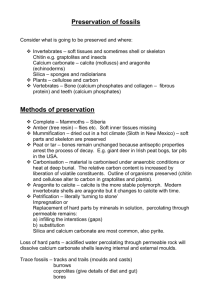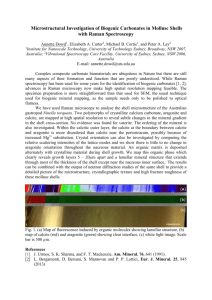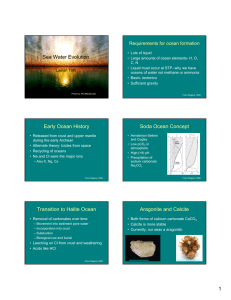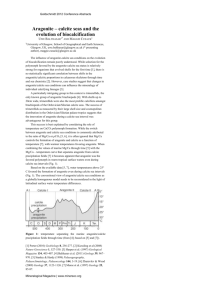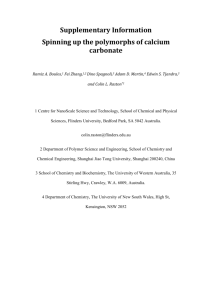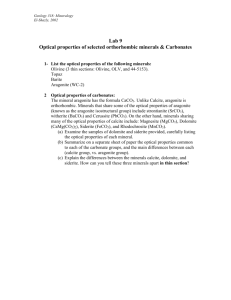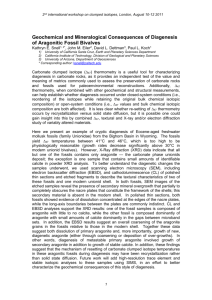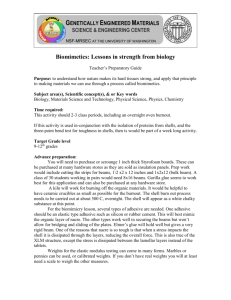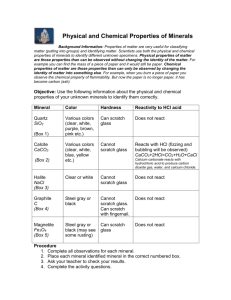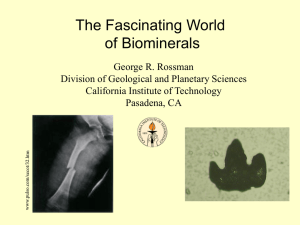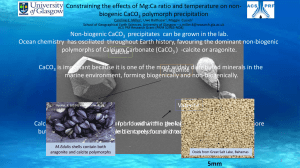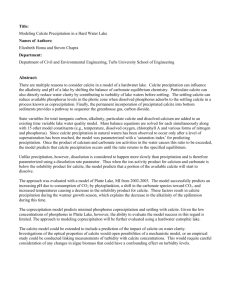Fossilization
advertisement
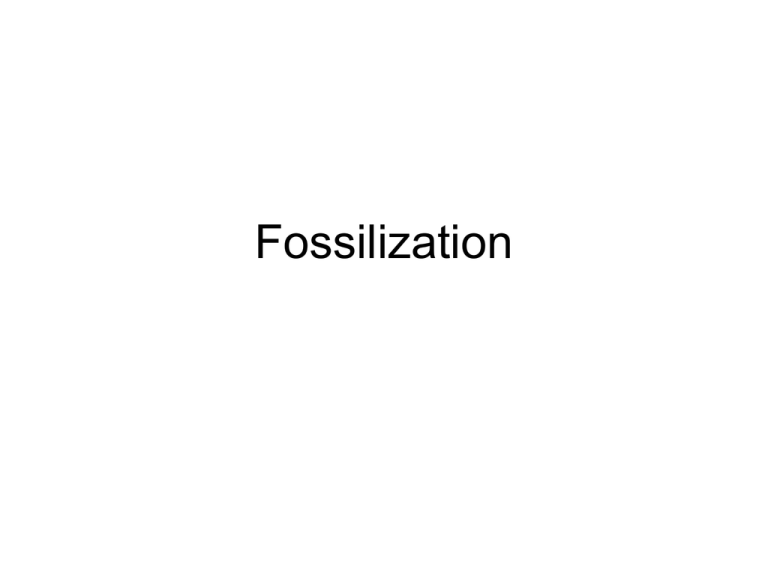
Fossilization • I. Possess hard parts • II. Get buried • III. Become preserved over the long term – Permineralization - petrification, precipitation of minerals in skeletal pores. – Recrystalization- mineral reorganization of shell material, destroys original microstructure. – Replacement- substitution of a mineral substance, simultaneous substitution-Pyrite, Calcite, Dolomite, Iron Oxides, Silica – Carbonization - thin film of carbon residue due to volatilization of H 2 , O2 , N 2 – Molding and casting - Negative impressions and positive images in sediment. • IV. Avoid dissolution • V. Become exposed over the long term. Tectonic uplift essential • VI. Get discovered TAPHONOMY • Processes that occur between the death of an organism and its subsequent burial in the sediment are termed biostratinomy. • Generally, this includes the decomposition and scavenging of the animal's soft parts, and at least some amount of post-mortem transport. • Such things as the amount of shell breakage and the concentration of shells in layers often indicate the level of water energy and post-mortem transport. • For example, the shell-hash or coquina has experienced a significant amount of shell breakage and probably post-mortem transport suggesting deposition in high energy environments; whereas, intact articulated plant remains suggest little or no post-mortem transport and deposition in a very low energy and oxygen-free environment. The field of Taphonomy as it relates to steps in transformation from living organisms to fossils Death Preservation- Unaltered Soft Parts • 1. Remains of mammoth and rhinoceroses in frozen tundras of Siberia and North America. • 2. Insect exoskeletons and minute appendages have been preserved in amber, the hardened resin of ancient coniferous trees. (The Jurassic Park scenario) • 3. In Poland an Ice Age wooly rhinoceros was well preserved in asphalt and the La Brea Tar Pits of Los Angeles contain many Pleistocene animals. • 4. In semi-arid South America, parts of mummified ground sloths have been preserved in caves. • 6. Algae and bacteria have been reported preserved in Precambrian chert. Preservation- Unaltered Hard Parts • 1. Calcite (CaCO3 is the most abundant original skeletal material found in fossils • 2. Aragonite (CaCO3) is preserved in the shells of some corals and molluscs. Rare in late Paleozoic fossils, absent from older ones, since aragonite tends to invert into the more stable calcite or dissolves. • 3. Tricalcium Phosphate (Ca3(PO4)2) is a chemically resistant mineral found unaltered in vertebrate bones, some arthropods and brachiopods. • 4. Opal (SiO2H2O) is an amorphous hydrated silica preserved in latter geologic time in some Protozoans and sponges. It is unstable. • 5. Chitin is an organic compound that is resistant to bacterial action and is not readily altered. It is found in many arthropods and graptolites Permineralization • (Petrification) process whereby porous skeletons are made denser and heavier by precipitation of minerals by ground water in the open spaces or pores of the skeletons. E.g. calcite, silica and glauconite Recrystalization • Refers to the process whereby the shell material undergoes reorganization that partly or completely destroys the original microstructure • This is a common phenomenon in shells which were originally aragonite and/or calcite (both forms of calcium carbonate- CaCO3). – Examples, both of which are now calcite, include a gastropod which was originally aragonite and a brachiopod which was originally calcite Replacement • Refers to mineral substances being substituted for the hard parts (sometimes even soft part) of organisms, probably by simultaneous solution and precipitation. – Pyrite (FeS2) frequently replaces shells: pyritization. – Calcite may replace silica, calcite and aragonite:calcification. – Dolomite (CaMg(CO3)2) may replace calcite or aragonite shells: dolomitization. – Replacement may be done by iron minerals such as hematite or limonite. – Silica (chalcedony and quartz) commonly replaces calcareous skeletons: silicification. – Other carbonates (siderite, rhodochrosite) may also replace shells, though less commonly: calcification. Carbonization • Involves a decrease in volatile constituents of tissues and chitin such as hydrogen, oxygen and nitrogen, leaving a thin film of carbon. E.g. graptolites, plant remains Molds and Casts • Skeletons are frequently found completely dissolved away by meteoric and groundwaters, leaving molds (negative impressions) of their internal or external surfaces in the sediments enclosing them. • Casts are formed when sediment or mineral precipitates fill these molds. A cast is a positive image identical in symmetry to the original. As a general rule, if a shell has been dissolved away you most likely have a mold Trace Fossils • Tracks, trails and borings: imprints, burrows or tubes made by organisms are common. • Coprolites are fossil excreta. • Gastroliths: smooth rounded pebbles found in the stomachs of dinosaurs, an aid to digestion. • Artifacts: stone tools or weapons of humanoids Pseudofossils • Inorganic structures that may resemble an organism or part thereof or a trace or imprint of one. E.g. dendrites (manganese oxide), banded flint, desiccation cracks, tool marks, liesegang rings (rhythmic precipitation in a gel), soft-sediment deformation structures
